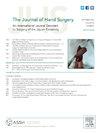腕管综合征的自主神经成分
IF 2.1
2区 医学
Q2 ORTHOPEDICS
引用次数: 0
摘要
腕管综合征(CTS)是最常见的压迫性神经病变。正中神经包括感觉、运动和交感神经纤维。在CTS中,不同的正中神经纤维受累可能不同;因此,感觉、运动或自主神经功能障碍之一可能占主导地位。正中神经的自主神经纤维由节后交感血管舒缩纤维和压迫运动纤维组成。轴质血流的不完全中断可能引起反射,增加交感神经活动,导致出汗、雷诺现象和手指苍白。交感神经轴浆流动的完全中断阻断了导致血管舒张的交感神经活动,而手部受影响的区域被认为比肢体的其他部分更肿胀、更热、更粉、更干燥。在晚期和严重的自主神经功能障碍中,指尖可能溃烂,指甲生长可能发生变化。腕管综合征的诊断是一系列症状和体征;然而,对CTS的自主神经成分的关注有限。单薄无髓交感神经纤维受压和轴突变性后再生和再神经支配能力较差。忽视CTS的自主神经成分的重要作用可能导致持续的症状和CTS手术失败。有自主神经表现的患者早期腕管释放是有意义的,可能会改善预后。本文章由计算机程序翻译,如有差异,请以英文原文为准。
Autonomic Component of Carpal Tunnel Syndrome
Carpal tunnel syndrome (CTS) is the most common compression neuropathy. The median nerve contains sensory, motor, and sympathetic fibers. Involvement of the different fibers of the median nerve in CTS may vary; hence, one of the sensory, motor, or autonomic dysfunctions may be dominant. Autonomic fibers of the median nerve consist of postganglionic sympathetic vasomotor and sudomotor fibers. An incomplete interruption of the axoplasmic flow may provoke a reflex that increases the sympathetic activity, leading to sweating, Raynaud phenomenon, and paleness of fingers. A complete sympathetic axoplasmic flow disruption blocks the sympathetic activity that leads to vasodilation, and the affected area in the hand is believed to be swollen, warmer, pinker, and dryer than the rest of the limb. In advanced and severe autonomic dysfunction, the fingertips may ulcerate, and nail growth changes may occur. Carpal tunnel syndrome diagnosis is a constellation of symptoms and signs; however, there has been limited attention to the autonomic component of CTS. Regeneration and reinnervation capacity of thin unmyelinated sympathetic fibers after compression and axonal degeneration is poor. Ignoring the important role of the autonomic component of CTS may lead to persistent symptoms and unsuccessful CTS surgery. Early carpal tunnel release in patients with autonomic findings is indicated and may provide improved outcomes.
求助全文
通过发布文献求助,成功后即可免费获取论文全文。
去求助
来源期刊
CiteScore
3.20
自引率
10.50%
发文量
402
审稿时长
12 weeks
期刊介绍:
The Journal of Hand Surgery publishes original, peer-reviewed articles related to the pathophysiology, diagnosis, and treatment of diseases and conditions of the upper extremity; these include both clinical and basic science studies, along with case reports. Special features include Review Articles (including Current Concepts and The Hand Surgery Landscape), Reviews of Books and Media, and Letters to the Editor.

 求助内容:
求助内容: 应助结果提醒方式:
应助结果提醒方式:


